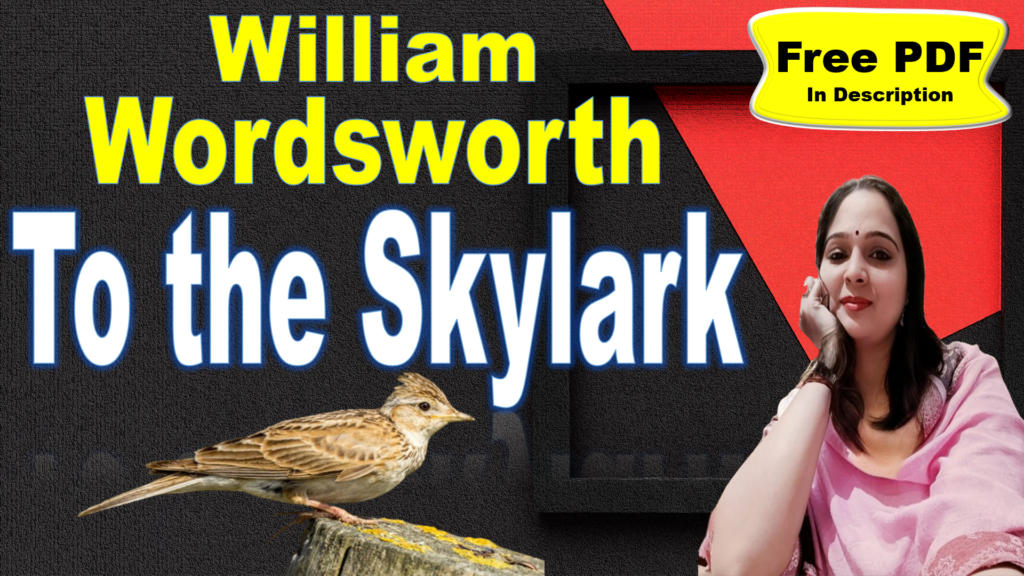
To the Skylark by William Wordsworth | To the Skylark | William Wordsworth | Explanation | Summary | Key Points | Word Meaning | Critical Appreciation | Questions Answers | Free PDF Download – Easy Literary Lessons
To the Skylark by William Wordsworth
Ethereal minstrel! pilgrim of the sky!
Dost thou despise the earth where cares abound?
Or, while the wings aspire, are heart and eye
Both with thy nest upon the dewy ground?
Thy nest which thou canst drop into at will,
Those quivering wings composed, that music still!
To the last point of vision, and beyond,
Mount, daring warbler!—that love-prompted strain
—’Twixt thee and thine a never-failing bond—
Thrills not the less the bosom of the plain:
Yet might’st thou seem, proud privilege! to sing All independent of the leafy Spring.
Leave to the nightingale her shady wood;
A privacy of glorious light is thine;
Whence thou dost pour upon the world a flood
Of harmony, with instinct more divine;
Type of the wise who soar, but never roam;
True to the kindred points of Heaven and Home!
To the Skylark line-by-line explanation
Ethereal minstrel! pilgrim of the sky!
Dost thou despise the earth where cares abound?
Or, while the wings aspire, are heart and eye
Both with thy nest upon the dewy ground?
Thy nest which thou canst drop into at will,
Those quivering wings composed, that music still!
Explanation: In the first stanza of “To the Skylark,” William Wordsworth addresses the skylark with admiration, referring to it as an “ethereal minstrel” and a “pilgrim of the sky.” These descriptions suggest that the skylark is a heavenly, almost otherworldly singer, soaring freely in the sky like a traveler on a spiritual journey. The poet wonders if the skylark, in its high flights, looks down upon the earth with disdain, as the earth is a place where “cares abound”—a world filled with worries and struggles.
However, Wordsworth quickly questions whether, despite the skylark’s soaring ambitions (“while the wings aspire”), its heart and eyes remain focused on its nest on the “dewy ground.” This nest symbolizes the bird’s home, its connection to the earth, and the essential things in life. The poet is curious if the skylark, even as it aspires to greater heights, keeps its love and attention grounded in its home.
The stanza concludes with the image of the skylark’s ability to return to its nest “at will,” whenever it desires. The bird’s “quivering wings” can be stilled, and its music can cease as it descends back to its earthly home. This illustrates the skylark’s unique balance between reaching for the sky and remaining connected to the earth, an existence that blends aspiration with a sense of belonging and stability.
Poetic devices
Apostrophe: The poem begins with an apostrophe, where the speaker directly addresses the skylark as “Ethereal minstrel! pilgrim of the sky!” This device creates a sense of immediacy and connection between the speaker and the skylark, drawing the reader into the scene as if the bird were present and capable of responding.
Metaphor: The skylark is metaphorically described as an “ethereal minstrel” and a “pilgrim of the sky.” These metaphors elevate the bird beyond its literal existence, portraying it as a heavenly singer and a spiritual traveler. The use of “ethereal” suggests something light, airy, and heavenly, while “minstrel” conveys the idea of a musician or poet. “Pilgrim of the sky” suggests a journey or quest, emphasizing the bird’s ascent into the heavens.
Rhetorical Questions: The stanza contains rhetorical questions such as “Dost thou despise the earth where cares abound?” and “Or, while the wings aspire, are heart and eye / Both with thy nest upon the dewy ground?” These questions serve to express the speaker’s curiosity and wonder about the skylark’s relationship with the earth and sky. They also invite the reader to ponder the same questions, deepening the engagement with the poem.
Imagery: Vivid imagery is used throughout the stanza to create a strong visual and emotional impact. Phrases like “earth where cares abound,” “wings aspire,” “nest upon the dewy ground,” and “quivering wings composed” paint a clear picture of the skylark’s environment and actions. The contrast between the “earth where cares abound” and the skylark’s “nest upon the dewy ground” highlights the tension between the mundane world and the bird’s ethereal existence.
Alliteration: The repetition of consonant sounds is used subtly to create rhythm and musicality in the stanza. For example, the “w” sound in “while the wings aspire” and “with thy nest” adds a flowing, soft quality to the lines, reflecting the gentle movement of the skylark’s flight.
Enjambment: The use of enjambment, where a sentence or phrase runs over from one line to the next without a pause, is evident in lines like “Or, while the wings aspire, are heart and eye / Both with thy nest upon the dewy ground?” This device creates a sense of continuity and movement, mirroring the skylark’s ascent and the fluidity of its flight.
To the last point of vision, and beyond,
Mount, daring warbler!—that love-prompted strain
—’Twixt thee and thine a never-failing bond—
Thrills not the less the bosom of the plain:
Yet might’st thou seem, proud privilege! to sing
All independent of the leafy Spring.
Explanation: In this stanza, the speaker urges the skylark to soar to the farthest point of sight and even beyond, celebrating its daring flight and the music inspired by love. The skylark’s song, which is a product of its deep emotional bond with its home, continues to stir and affect the heart of the plain below, despite its lofty position.
The speaker acknowledges that the skylark might appear to have the unique privilege of singing independently of the changing seasons, such as the leafy Spring. This highlights the skylark’s ability to create beautiful music that transcends the typical constraints of nature and seasonal changes. The bird’s song is portrayed as being so powerful and distinct that it remains influential and moving even when the bird itself is detached from the ordinary aspects of the earthly environment.
Poetic Device
Imagery: The stanza creates vivid images of the skylark soaring to the last point of vision and beyond, which helps readers visualize the bird’s high flight and expansive reach. The phrase “love-prompted strain” evokes an image of music inspired by deep emotions.
Personification: The skylark is given human-like qualities, such as being described as a “daring warbler” and possessing a “love-prompted strain.” Personification attributes human traits to the bird, emphasizing its courage and emotional depth.
Metaphor: The skylark’s song is described as a “never-failing bond” between the bird and its home, suggesting a deep, unbreakable connection. The term “proud privilege” is a metaphor for the unique ability of the skylark to sing regardless of the changing seasons.
Contrast: The stanza contrasts the skylark’s “proud privilege” of singing “independent of the leafy Spring” with the more seasonal and localized song of the nightingale. This contrast highlights the skylark’s exceptional nature and its ability to transcend typical constraints.
Enjambment: The lines flow into one another without a pause, particularly in phrases like “Mount, daring warbler!—that love-prompted strain / —’Twixt thee and thine a never-failing bond—.” This technique creates a sense of continuity and movement, mirroring the skylark’s flight.
Hyperbole: The description of the skylark’s song as a “flood / Of harmony” uses hyperbole to emphasize the overwhelming and abundant beauty of its music. This exaggeration underscores the grandeur of the skylark’s song.
Leave to the nightingale her shady wood;
A privacy of glorious light is thine;
Whence thou dost pour upon the world a flood
Of harmony, with instinct more divine;
Type of the wise who soar, but never roam;
True to the kindred points of Heaven and Home!
Explanation: In the second stanza of “To the Skylark,” William Wordsworth contrasts the skylark with the nightingale, another bird often celebrated in poetry. The poet suggests that the nightingale should be left to its “shady wood,” where it sings in the privacy and seclusion of the forest. This environment symbolizes the nightingale’s preference for solitude and darkness, where its song is heard only by those who venture into its hidden world.
In contrast, the skylark is depicted as having a “privacy of glorious light.” Instead of hiding in the shadows, the skylark sings openly in the bright, clear sky, where its song reaches far and wide. This “privacy of glorious light” symbolizes the skylark’s connection to the divine and the openness with which it shares its song with the world. The bird’s melody is not confined or secretive but is a “flood of harmony” that pours out over the earth, guided by an instinct that Wordsworth describes as “more divine” than that of the nightingale.
The skylark is seen as a “Type of the wise who soar, but never roam,” embodying the ideal of those who aspire to great heights but remain grounded and true to their origins. Unlike those who wander aimlessly or lose themselves in their ambitions, the skylark maintains a balance between its lofty aspirations and its connection to home. The phrase “True to the kindred points of Heaven and Home” captures this duality, where the skylark represents a perfect harmony between spiritual elevation (“Heaven”) and earthly attachment (“Home”). Wordsworth admires this balance as an example of wisdom, where one can achieve greatness without losing sight of what truly matters.
Poetic Device
Contrast: The stanza begins with a clear contrast between the nightingale and the skylark. The nightingale is associated with a “shady wood,” symbolizing darkness and seclusion, while the skylark is given a “privacy of glorious light,” representing openness, divinity, and the ethereal. This contrast highlights the different ways each bird connects with the world and symbolizes different aspects of human experience.
Metaphor: Wordsworth uses metaphors to describe the skylark’s environment and actions. “A privacy of glorious light” is a metaphor that suggests the skylark has its own private space in the open sky, filled with divine light. The “flood of harmony” metaphorically describes the skylark’s song as a powerful, overwhelming flow of music that fills the world. This metaphor emphasizes the skylark’s influence and the spiritual quality of its song.
Imagery: Vivid imagery is used to create a strong visual and auditory experience. The “shady wood” conjures images of darkness and seclusion, while “glorious light” evokes a sense of brightness and divinity. The “flood of harmony” creates an auditory image of the skylark’s song pouring out into the world, filling it with divine music. This imagery helps to reinforce the skylark’s role as a symbol of spiritual and intellectual elevation.
Alliteration: Alliteration is subtly used to enhance the musicality of the stanza. For example, ” True to the kindred points of Heaven and Home” feature the repetition of the “H” sound.
Symbolism: The skylark and nightingale are both symbolic. The nightingale symbolizes traditional, secluded beauty and introspection, while the skylark symbolizes open, divine inspiration and wisdom. The skylark is described as a “Type of the wise who soar, but never roam,” symbolizing those who aspire to great heights while remaining grounded and true to their origins, balancing ambition with stability.
Antithesis: The stanza presents an antithesis between soaring and roaming, particularly in the line “Type of the wise who soar, but never roam.” Soaring represents high aspirations and spiritual elevation, while roaming suggests aimlessness and a lack of purpose. The wise are those who can reach great heights without losing their direction or connection to their roots.





